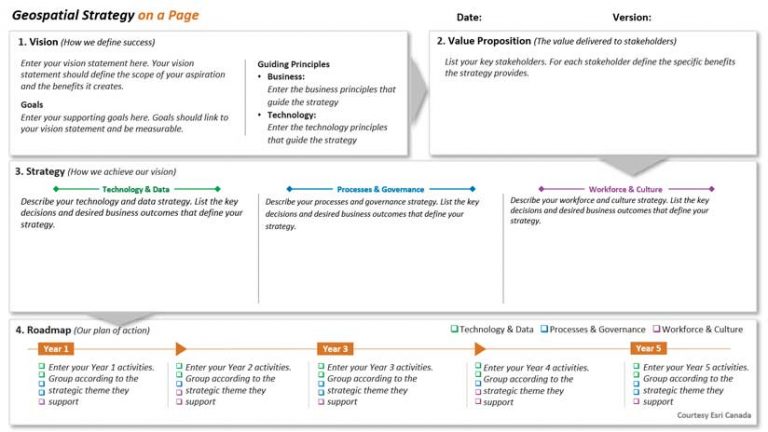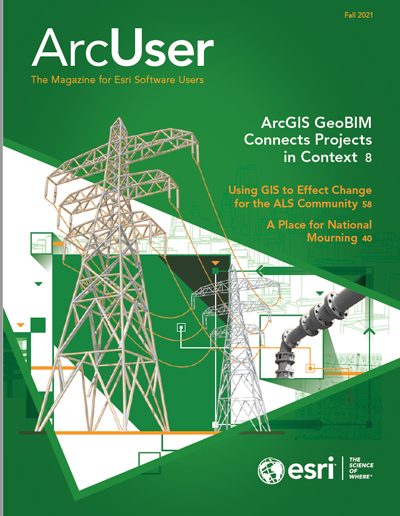To move from developing a planning strategy to its successful implementation requires an ongoing commitment from all stakeholders. You need a simple, stripped-down visual that communicates the goals and direction of the strategy so that it doesn’t become shelfware. You need a one-page geospatial strategy. This article takes you through the four main elements of the strategy on a page—vision, value proposition, strategy, and road map—and provides tips and guidance on its use.
Creating a strategy on a page takes work. There are no shortcuts when it comes to understanding business needs, setting a strategic direction, or devising an implementation plan. The one-page approach is simply a tool to distill a geospatial strategic plan down to its critical elements so that your team can keep it front and center in your quest for geospatial excellence.
1. Vision
The first element of the strategy on a page summarizes your vision and includes your vision statement, supporting goals, and guiding principles. Together, these three components articulate how your organization defines success with geospatial.
The vision statement is the first and perhaps most important component. A well-crafted vision statement is your organization’s “North Star.” It describes a future in which your geospatial aspirations have been realized. It also functions as a guide for future strategic decisions.
To create an impactful vision statement, focus on future outcomes. Some good questions to ask when defining your vision statement can include the following:
- How will geospatial technology benefit our stakeholders?
- What is the scope of our aspirations?
Here’s a nice example of a vision statement written for an energy transmission business:
“Our geospatial capabilities will accelerate the efficiency and effectiveness of spatial planning and decision-making across the organization and provide access to secure, high-quality spatial information across the full span of our asset base anytime, anywhere.”
Developing your vision statement will take time. It’s a bit of an art, so prepare a few different versions until you land on one that most of the people developing your strategy can agree with.
Goals and Guiding Principles
Supporting goals and guiding principles are connected to your vision statement. These goals describe the desired outcomes in your vision statement with an additional level of detail. Goals help you assess progress toward your vision. Ideally, that means your goals should be measurable so that you have an objective indicator of success.
Using the vision statement written for an energy transmission business as an example, you will need to define “accelerate the efficiency and effectiveness of spatial planning and decision-making.” Accelerate efficiency and effectiveness by how much? Accelerate efficiency and effectiveness by the same amount for spatial planning as for decision-making?
The terms used in a vision statement are often vague, so refining them in the process of setting your supporting goals helps everyone understand what you’re striving for. If you’re struggling to define measurable goals, it’s often because your vision statement needs more work. Fine-tune it until you have a statement that links clearly to specific goals.
Guiding principles—both business and technical—make up the final piece of the vision element. They are like guideposts for strategic decisions but are different from goals because they don’t signify an accomplishment. They provide ongoing, enduring guidance regardless of how plans change. They’re most valuable as a litmus test of the strategic decisions identified in the strategy stage to ensure that strategies align with the principles and values of the organization.
From a technical perspective, minimizing system customization and favoring cloud-based deployment are identified as principles. On the business side, encouraging cross-functional collaboration and providing demonstrable business value are common principles.
2. Value Proposition
The second element of the strategy on a page is the value proposition. It describes the benefits of your strategy to the stakeholders in your organization. This should be a straightforward statement that describes what each group stands to gain from the strategy. It should answer the question, What’s in it for me?
The key is identifying the right mix of roles in your organization. They should reflect specific business functions on one hand and general user types on the other. The point is to highlight the cross section of stakeholders who will receive the greatest value from your geospatial strategy.
You’ll create one value proposition statement for each role you identify. The wording of each statement should speak to the interests of the role. For example, “Our solutions provide inspectors with real-time access to maps, as-builts, and work orders on any mobile device in the appropriate geographic context” might be a value proposition statement for field inspectors.
You’ll need to be concise. After all, the real estate on one page is limited. The trick is to balance brevity with communicating the unique benefits that geospatial technology provides. Make it short and snappy.
3. Strategy
The third element of the strategy on a page is the most involved. It is the strategy section itself. This section answers the question, How do we achieve our vision?
This section is organized around the three building blocks of a geospatial capability: technology and data, processes and governance, and workforce and culture.
Technology and data: Focuses on the technical aspects of your strategy, including business applications, geospatial data, and IT infrastructure
Processes and governance: Focuses on operational and administrative functions, including service delivery processes and governance practices
Workforce and culture: Focuses on your human capital, including the knowledge, skills, and responsibilities of your geospatial workforce and the culture of spatial thinking
The strategy element highlights choices and expected outcomes that define each of the three building blocks. Remember, the purpose of a geospatial strategy is to create sustainable geospatial capabilities that enable your organization to achieve its vision. You have limited space, so showcase the decisions and outcomes that define these capabilities.
Technology and Data
For the technology and data portion, highlight strategic decisions that result in significant changes to your application portfolio, data environments, and practices, or IT infrastructure. For each decision you highlight, indicate the business outcome you expect to result from this decision. The business outcome provides a level of justification for each decision. For example, the decision to migrate internally managed solutions, data, and customizations to software as a service (SaaS) would support an outcome of improved performance and the reduction of internal security and application maintenance requirements.
Processes and Governance
For the processes and governance portion, include strategic decisions that establish or change processes related to how geospatial technology and services are managed and supported or how you oversee and monitor the effectiveness of your overall geospatial investment. A decision to establish a formal geospatial governance structure composed of IT, GIS, and department representatives could produce an outcome that would provide accountability, clarify decision-making, and issue resolution procedures.
Workforce and Culture
The workforce and culture portion summarizes decisions that impact your workforce complement, the level of spatial literacy across your organization, and the culture of spatial thinking. Explicitly state how you plan to alter your human capital to reflect changes introduced in your technology and data and processes and governance portions.
A decision to develop persona-based professional development pathways and curriculum for key geospatial roles could lead to an outcome of aligning staff knowledge and skills with evolving technology capabilities.
Here is one additional tip. For each section, organize the strategic decisions in order of relative importance. Evaluate each decision’s level of significance in terms of advancing your goals and the degree of impact it will have on the organization.
These decisions will generate the most conversation and scrutiny, so put them front and center. It’s better to be open and honest about the direction you’re advocating rather than have it come as a surprise later. Your strategy on a page is a vehicle for expressing the most important and impactful aspects of your strategy. Don’t bury key critical decisions in the details.
4. Road Map
The final element of the strategy on a page is the road map. This section describes the sequence of activities required to implement your strategy. Typical road maps span three to five years, but you can design one of any duration that makes sense in terms of timing and effort. To fit the road map into the strategy on a page, you’ll need to summarize activities into discrete work packages because you won’t have room to itemize every job and task. You’ll need to be thoughtful about what you present.
One way to do this is to group related or dependent activities into projects and categorize them into common themes. For example, you can organize projects according to the three strategy components they support (namely, technology and data, processes and governance, or workforce and culture). You can also group them by business project: GIS, IT, asset management, and department focus. You could also simply group them into technical and nontechnical projects. No matter how you formulate the groupings, the point is to clearly link the planned activities with the direction described in the strategy.

Once you have completed your strategy on a page, be sure to use it. Print it out, bring it to meetings, and display it prominently where everyone can see it. Highlight the strategy in presentations and share it on your corporate network. Use it when engaging new business areas, or even print it as a large poster for GIS Day. Your strategy on a page is an ideal awareness-building tool—use it to its full potential.
Good luck, and if you need any help, please reach out to the authors.




